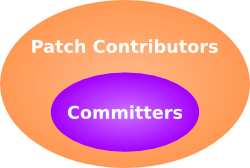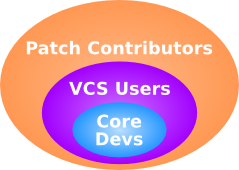One thing that has been mentioned in the GNOME DVCS debate was that it is as easy to do “git diff” as it is to do “svn diff” so the learning curve issue is moot. I’d have to disagree here.
Traditional Centralised Version Control
With traditional version control systems (e.g. CVS and Subversion) as used by Free Software projects like GNOME, there are effectively two classes of users that I will refer to as “committers” and “patch contributors”:

Patch contributors are limited to read only access to the version control system. They can check out a working copy to make changes, and then produce a patch with the “diff” command to submit to a bug tracker or send to a mailing list. This is where new contributors start, so it is important that it be easy to get started in this mode.
Once a contributor is trusted enough, they may be given write access to the repository moving them to the committers group. They now have access to more functionality from the VCS, including the ability to checkpoint changes into focused commits, possibly on branches. The contributor may still be required to go through patch review before committing, or may be given free reign to commit changes as they see fit.
Some problems with this arrangement include:
- New developers are given a very limited set of tools to do their work.
- If a developer goes to the trouble of learning the advanced features of the version control system, they are still limited to the read only subset if they decide to start contributing to another project.
Distributed Workflow
A DVCS allows anyone to commit to their own branches and provides the full feature set to all users. This splits the “committers” class into two classes:

The social aspect of the “committers” group now becomes the group of people who can commit to the main line of the project – the core developers. Outside this group, we have people who make use of the same features of the VCS as the core developers but do not have write access to the main line: their changes must be reviewed and merged by a core developer.
I’ve left the “patch contributor” class in the above diagram because not all contributors will bother learning the details of the VCS. For projects I’ve worked on that used a DVCS, I’ve still seen people send simple patches (either from the “xxx diff” command, or as diffs against a tarball release) and I don’t think that is likely to change.
Measuring Success
Making the lives of core developers better is often brought up as a reason to switch to a DVCS (e.g. through features like offline commits, local cache of history, etc). I’d argue that making life easier for non core contributors is at least as important. One way we can measure this is by looking at whether such contributors are actually using VCS features beyond what they could with a traditional centralised setup.
By looking at the relative numbers of contributors who submit regular patches and those that either publish branches or submit changesets we can get an idea of how much of the VCS they have used.
It’d be interesting to see the results of a study based on contributions to various projects that have already adopted DVCS. Although I don’t have any reliable numbers, I can guess at two things that might affect the results:
- Familiarity for existing developers. There is a lot of cross pollination in Free Software, so it isn’t uncommon for a new contributor to have worked on another project before hand. Using a VCS with a familiar command set can help here (or using the same VCS).
- A gradual learning curve. New contributors should be able to get going with a small command set, and easily learn more features as they need them.
I am sure that there are other things that would affect the results, but these are the ones that I think would have the most noticeable effects.
In my opinion DVCS gives the exact same workflow than VCS, you can just use the diff command of your tool and attach the patch on bugzilla. DVCS gives more power to contributors/commiters that wants/need more complex things. So that’s a 100% gain and nothing is lost… There is nothing to study, discuss, troll, etc. DVCS is simply better and it’s obviously a shame that GNOME still use the worst system ever (equality with CVS).
Any DVCS can do the job, all we need is an admin that pick a random one and make the move without asking what the community wants because the community will never agree.
CVS vs SVN vs DVCS is really a non-issue for me as a “patch contributor”
The big win would be if maintainers of GNOME packages actually opened bugzilla, reviewed and then either rejected with reasons or applied the multitude of patches there. Patches that represent rather a lot of work done by volunteers who are not being treated with basic politeness when the patches are just ignored. Right now patch review isn’t happening. Why not? Fixing that is the win. Without fixing that you’re just pissing into the wind. I don’t want to fix more GNOME bugs and waste more of my time if this is the attitude of GNOME devs. DVCS will not fix that and will yield zero benefit as far as getting more people more involved. As ever the start would be treating people with the proper respect, which is not at all a function of their patch quality. Are you with me on this?
BTW hope all is well with you in the west and this rubbish of you being a proprietary software developer nowadays ends with a proper release under and OSI license. Maybe catch you for a beer at the next LCA.
The question is, do we have any evidence that the VCS Users group has any members outside “core devel”?
xclaesse: I agree that almost any use of DVCS is a gain. The question is how much gain the various tools give, which I think would be worth investigating as there are some objective metrics that can be checked.
Hal: I didn’t mean “patch contributor” as a negative. Many people who submit plain patches simply have better things to do than learn about DVCS features. I think a good DVCS is one that makes it easy for such a person to start using just the features that make them more productive without needing to invest a large amount of time.
jldugger: I don’t have any evidence, but I believe that it should be possible to gather such evidence (either for or against).
James, I have better things to do than contribute patches when they will be totally ignored, regardless of whether they fix actual bugs for which bugzilla entries existed prior to my attaching a patch. Now I don’t mind if after review the maintainer says this isn’t the way forward, but why should I spend 5 or 6 hours coming to grips with some part of a codebase to fix a known bug in GNOME if GNOME maintainers can’t be bothered to look at bugzilla then apply or reject the patch?
Seriously how on earth does the choice of revision control system used affect me in this situation? It would be the same with source tarballs as with the funkiest DVCS imaginable. Ignored work is ignored.
So please don’t use “patch contributor” efficiency as an argument for anything unless you’re going to actually do something about getting the patches, whatever method is used to generate them, reviewed. Reviewing the patches is the win, VCS is just NOT REMOTELY interesting AT ALL to “patch contributors” until that happens. Changing which Editor I use won’t help me write better code. DVCS won’t get patches reviewed. If it did, many of us would even use visual source safe if that would help. Oh by the way I can generate patches with cvs, svn, git, baz, bzr, hg and diff. Just about any “patch contributor” will be in the same boat. At the risk of labouring “labouring the point” the VCS I prefer is the one used by the project that reviews the patches submitted in bugzilla.